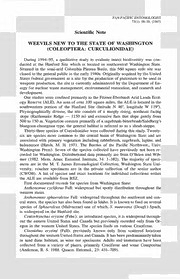
Weevils new to the state of Washington (Coleoptera: Curculionidae) PDF
Preview Weevils new to the state of Washington (Coleoptera: Curculionidae)
PAN-PACIFIC ENTOMOLOGIST 73(1): 58-59, (1997) Scientific Note WEEVILS NEW TO THE STATE OF WASHINGTON (COLEOPTERA: CURCULIONIDAE) During 1994-95, a qualitative study to evaluate insect biodiversity was con¬ ducted at the Hanford Site which is located in southcentral Washington State. Situated in the semi-arid Columbia Plateau Basin, this 560 square mile site was closed to the general public in the early 1940s. Originally acquired by the United States federal government as a site for the production of plutonium to be used in weapons production, the site is currently administered by the Department of En¬ ergy for nuclear waste management, environmental restoration, and research and development. Our studies were confined primarily to the Fitzner-Eberhardt Arid Lands Ecol¬ ogy Reserve (ALE). An area of over 100 square miles, the ALE is located in the southwestern portion of the Hanford Site (latitude N 46°, longitude W 119°). Physiographically diverse, the site consists of a steeply rising, northeast facing slope (Rattlesnake Ridge — 1150 m) and extensive flats that slope gently from 500 to 150 m. Vegetation consists primarily of a sagebrush-bitterbrush/Sandberg’s bluegrass-cheatgrass type, the general habitat is referred to as a shrub-steppe. Thirty-three species of Curculionidae were collected during this study. Twenty- six are species more common to the central basin of Washington State and are associated with primary vegetation including rabbitbrush, sagebrush, lupine, and balsamroot (Hatch, M. H. 1971. The Beetles of the Pacific Northwest., Univ. Washington Press). Seven of the species collected have previously not been re¬ corded for Washington. Distributional data primarily are from O’Brien and Wib- mer (1982. Mem. Amer. Entomol. Institute, 34: 1-382). The majority of speci¬ mens are in the M. T. James Entomological Collection, Washington State Uni¬ versity; voucher specimens are in the private collection of the senior author (CWOB). A list of species and exact locations for individual collections within the ALE are available from RSZ. First documented records for species from Washington State: Anthonomus cycliferus Fall: widespread but spotty distribution throughout the western states. Anthonomus sphaeralciae Fall: widespread throughout the southwest and cen¬ tral states, the species has also been found in Idaho. It is known to feed on several species of Sphaeralcea (Malvaceae) one of which, S. munroana (Dougl.) Spach, is widespread on the Hanford site. Ceutorhynchus erysimi (Fabr.): an introduced species, it is widespread through¬ out the eastern United States and Canada but previously recorded only from Or¬ egon in the western United States. The species feeds on various Cruciferae. Cleonidius erysimi (Fall): previously known only from scattered locations throughout the western United States and Canada. It has been predominantly taken in sand dune habitats, as were our specimens. Adults and immatures have been collected from a variety of plants, primarily Cruciferae and some Compositae (Anderson, R. S. 1988. Quaest. Entomol., 23: 431-709). 1997 SCIENTIFIC NOTE 59 Gymnetron pascuorum (Gyllenhal): an introduced species that is widespread throughout much of the eastern and western United States. It has been reared from Plantago lanceolata (L.) (English plantain) (Hatch, M. H. 1971. The Beetles of the Pacific Northwest. Univ. Washington Press) which is widespread and com¬ mon on the Hanford site. Lepesoma remota (Van Dyke): previously known only from Oregon. Mecinus pyraster (Herbst): an introduced species previously known only from Maryland, New Jersey, Florida, Virginia, and Oregon. The primary larval host is Plantago (Plantaginaceae) but Mecinus have also been found feeding in several genera of Scrophularaceae (Warner, R. E. 1955. Entomol. News, 66: 209-211). Acknowledgement.—This project was funded by The Nature Conservancy with awards from the U. S. Department of Energy, The Nature Conservancy of Wash¬ ington State, and The Bullitt Foundation. Charles W. O’Brien, Entomology-Biological Control, Florida A&M University, Tallahassee, Florida 32307-4100 and Richard S. Zack, James Entomological Col¬ lection, Department of Entomology, Washington State University, Pullman, Wash¬ ington 99164-6382. Received 27 Feb 1996; Accepted 16 Oct 1996.
